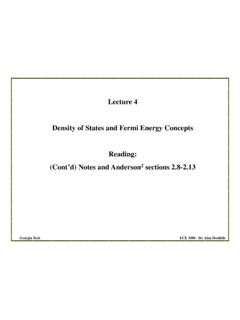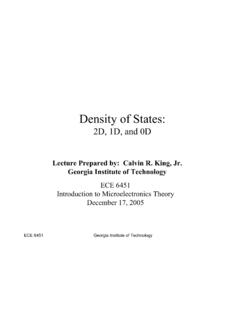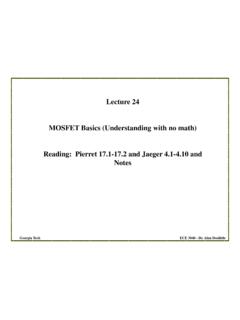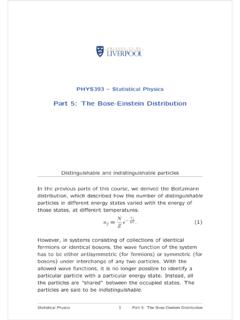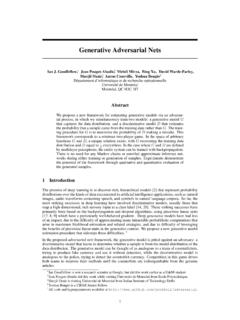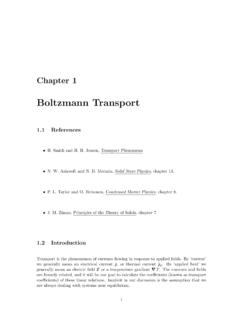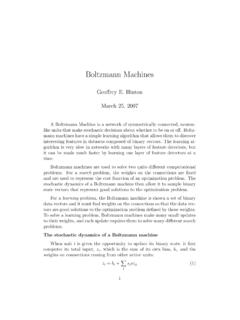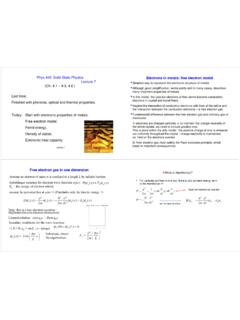Transcription of The Maxwell-Boltzmann Distribution Brennan 5
1 ECE6451-1 The Maxwell-Boltzmann DistributionBrennan prepared by Melanie HillECE6451-2 Maxwell-Boltzmann DistributionScottish physicist James Clerk Maxwell developed his kinetic theory of gases in 1859. Maxwell determined the Distribution of velocities among the molecules of a gas. Maxwell's finding was later generalized in 1871 by a German physicist, Ludwig boltzmann , to express the Distribution of energies among the made four [1] McEnvoy, and Zarate, Oscar; Introducing Quantum Theory; 2004[2] pictured the gas to consist of billions of molecules moving rapidly at random, colliding with each other and the walls of the was qualitatively consistent with the physical properties of gases, if we accept the notion that raising the temperature causes the molecules to move faster and collide with the walls of the container more frequently.
2 [1][2]ECE6451-3 The diameter of the molecules are much smaller than the distancebetween themMaxwell- boltzmann DistributionMaxwell s Four Assumptions[1]xDDThe collisions between moleculesconserve energyThe molecules movebetween collisions withoutinteracting as a constantspeed in a straight lineThe positions and velocitiesof the molecules areINITIALLY AT RANDOMG reatinsight![1] McEnvoy, and Zarate, Oscar; Introducing Quantum Theory; 2004 ECE6451-4 Maxwell-Boltzmann DistributionBy making these assumptions, Maxwell could compute the probability that a molecule chosen at random would have a particular set of curves is called the Maxwell Distribution . It provides useful information about the billions and billions of molecules within a system; when the motion of an individual molecule can t be calculated in practice. [1]We will derive the Maxwell-Boltzmann Distribution , which will provide useful information about the energy.
3 [1] McEnvoy, and Zarate, Oscar; Introducing Quantum Theory; 2004[1]Raising the temperature causes the curve to skew to the right, increasing the most probable DistributionWhy use statistical mechanics to predict molecule behavior? Why not just calculate the motion of the molecules exactly?Even though we are discussing classical physics, there exists a degree of uncertainty with respect to the fact that the motion of every single particle at all times cannot be determined in practice in any large if we were only dealing with one mole of gas, we would still have to determine characteristics of 6x1023molecules!!Maxwell s theory was based on statistical averages to see if the macrostates, ( measurable, observable) could be predicted from the DistributionIn Section , it was determined that the thermal equilibrium is established when the temperatures of the subsystems are equal.
4 Is the nature of the equilibrium Distribution for a system of Nnon-interacting gas particles?The equilibrium configuration corresponds to the most probable (most likely) configuration of the the simplest case, a system of Nnon-interacting classicalgas particles. Classical system: there are no restrictions on how many particles can be put into any one state simultaneously the particles are distinguishable, each particle is labeled for all timeFirst, we ll need to determine the number of microstates within any given configuration, the number of ways in which Nobjects can be arranged into ndistinct groups, also called the Multiplicity DistributionThe Multiplicity Function - determine the number of ways in which Nobjects can be arranged into the first twelve letters of the alphabet:a b c d e f g h i j k lArrange the letters into 3 containers without replacement.
5 Container 1holds 3 letters, Container 2holds 4 letters, and Container 3holds 5 letters.| _ _ _ || _ _ _ _ || _ _ _ _ _ |For the 1stslot, there are 12 possibilities.| c_ _ || _ _ _ _ || _ _ _ _ _ |For the 2ndslot, there are 11 possibilities.| ch_ || _ _ _ _ || _ _ _ _ _ |For the 3rdslot, there are 10 possibilities.| chk|| _ _ _ _ || _ _ _ _ _ | are 12!possible arrangements if the containers are Distribution (cont.) The Multiplicity Function -determine the number of ways in which Nobjects can be arranged into ncontainersSince we care about the containers but we don t care about the order of the letters within each container, we divide out the number of arrangements within each given container, resulting in:720,27!5!4!3!12= There are 27,720ways of partitioning 12 letters into the 3 containersThe Multiplicity Function:In general, the number of distinct arrangements of Nparticles into ngroups containing N1, N2.
6 , Ni, .., Nnobjects becomes:!..!..!!!21niNNNNN == =niininiNNNNNNNNNNNQ12121!!!..!..!!!),.. ,,..,,(Where Niis the number of objects in container iECE6451-9 Maxwell-Boltzmann DistributionPhysically, each container corresponds to a state in which each particle can be put. In the classical case,there are no restrictions on how many particles that can be put into any one container or state See Section for the quantum casewhere there are restrictions for some particlesThe states are classified in terms of their energy, Ei, and degeneracy, giThink of the system as ncontainerswith , how can we arrange Niparticles in these gisubcontainers?Each level has gidegenerate statesinto which Niparticles can be arrangedThere are nindependent levelsEiEi+1Ei-1 Degenerate states are different states that have the same energy level.
7 The number of states available is known as the degeneracyof that DistributionSince we are dealing with the classical case: there are no restrictions on how many particles can be put into any one subcontainer or state simultaneously the particles are distinguishable, each particle is labeled for all timeSo, how many arrangements of Niparticles in these gisubcontainers are possible?Consider an example where we have 3 particles and 2 subcontainers:RGB3 particles2 subcontainersncontainers with gisubcontainers. ECE6451-11 Maxwell-Boltzmann Distribution (cont.) How many arrangements of Niparticles in these gisubcontainers are possible?RGBRGBRGBRGBRGBRGBRGBRGBT here are 8possible arrangements, or 23In general, the possible arrangements of Niparticles into gisubcontainers is:iNigTherefore, if our system has a particular state that has a particular degeneracy, there is an additional multiplicity ofiNigfor that particular Distribution (cont.)
8 Therefore, the totalMultiplicity Function for a collection of classical particles is:Constraint 1 implies:There are two physical constraints on our total number of particles must be total energy of the system must be conservedwhere Uis the total energy for the system == =niNiniiniigNNNNNNQ1121!!),..,,..,,(NNni i== =1 Constraint 2 implies:UNEniii== =1 The equilibrium configuration corresponds to the most probable (most likely) configuration of the system, the configuration with the greatest multiplicity! To find the greatest multiplicity, we need to maximize Qsubject to DistributionFrom previous slide: == +=niiniiiNgNNQ11!lnln!lnln == =niNiniiniigNNNNNNQ1121!!),..,,..,,(This equation will be easier to deal with if we take the logarithm of both sides:xxxx ln!lnApplying Stirling s approximation, for large x: ===+ + =niiniiiniiiNNNgNNNNQ111lnlnlnln0ln= + jjjNNQN In order to maximize, we need to make use of Lagrange multipliers and Constraints 1 and 2:Almost exact because we re dealing with verylarge x, 1023particles!
9 The derivatives of the 1stand 2ndconstraints are zerobecause the constraints are equal to constantsAll we are doing is adding and subtractingconstants multiplied by zero!ECE6451-14 Maxwell-Boltzmann DistributionFrom previous slide:0ln= + jjjNNQN Substituting in ln Qand Constraints 1 and 2:011ln1ln= ++ + jjjjjENNNg Taking the derivative, noting that Nis constant and the only terms that are nonzero are when i= j:0lnlnln11111= + + + =====niiijniijniniiniiiiijNENNNNNNgNNNNN ===+ + =niiniiiniiiNNNgNNNNQ111lnlnlnln0lnln= + jjjENg ECE6451-15 Maxwell-Boltzmann DistributionFrom previous slide:To find , we need to determine the total number of particles, N, in the system and the total energy, E, of the the states are closely spaced in energy, they form a quasi-continuum and the total number of particles, N, is given by:Where D(E)is the Density of States Function found in Section =0)()(dEEDEfN0lnln= + jjjENg jjjEgN =lnjEjjjegNEf ==)(What are and ?
10 ECE6451-16 Maxwell-Boltzmann DistributionFrom previous slide:Using the standard integral: + + =01)1(naxnandxex23232)( hEmED=EjjegNEf ==)( =0)()(dEEDEfN =023232dEeEemNE h232323232 =emNhECE6451-17 Maxwell-Boltzmann DistributionThe total energy, E, of the system can be found by:Using the standard integral again: + + =01)1(naxnandxex23232)( hEmED=EjjegNEf ==)( =0)()(dEEDEEfE =02323232dEeEemEE h252323252 =emEhECE6451-18 Maxwell-Boltzmann DistributionThe average energy per particle is given as:Where kBis the boltzmann the average energy per particle with the ratio of our equations for Eand N:TkNEB23=NETkememNEB== =23232252232323252323 =TkB2323252325= ECE6451-19 Maxwell-Boltzmann DistributionFrom previous slide:TkB2323252325= TkB23232323= TkB2323= TkB1= () ()zzz =+ 1 Use the relationship[1]:[1] 37 ECE6451-20 Maxwell-Boltzmann DistributionNow we have but we still need.
